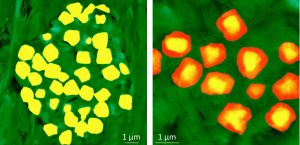The causes behind pyrite oxidation – and acid mine drainage
The researchers used their findings to develop a model to calculate pyrite oxidation rates at Shale Hills and across the globe
“Pyrite oxidation is a classic geologic and environmental problem, but we know little about the rate of pyrite oxidation occurring in deep rock,” Xin Gu, assistant research professor in Penn State’s Earth and Environmental Systems Institute and lead author of the study, said in a media statement. “When pyrite reacts with oxygen, it releases sulfuric acid, which can cause acid mine drainage, a serious environmental problem across the globe.”
When exposed to air, like in a mine, pyrite will fully oxidize in a matter of years. Microorganisms can also form on the mineral and speed up the reaction. The oxidation process happens quickly and allows sulfuric acid to accumulate. However, if left unmined deep below the surface, geologic processes slow the reaction by tens of thousands of years and prevent the acid from accumulating.
To conduct their analyses, the scientists lowered geophysical logging tools down boreholes 3-inches wide at the Susquehanna Shale Hills Critical Zone Observatory, which sits atop a shale formation. They recovered rocks from more than 100-feet deep to examine the shale bedrock and identify how deep or shallow pyrite weathers and fractures underground.

The team then studied grains of pyrite and how they turn into rust-type iron oxides using under scanning electron microscopes. This methodology helped them study the microstructures down to small features about 70 times thinner than a human hair and allowed them to identify the zone underground where pyrite oxidizes to a rust-type iron mineral at a very fine scale.
They found that the erosion rate of the shale controlled the rate of pyrite oxidation at depth. Microscopic fissures that form in the rock tens of feet below the surface are too small for microorganisms to enter.
In landscapes that erode over millennia, oxygen dissolved in water seeps into the openings and has plenty of time to catalyze the reaction, doing so in small quantities. When this occurs, the pyrite structurally retains its raspberry-like shape even though chemically it has transformed from iron sulfide to iron oxide.
The researchers used their findings to develop a model to calculate pyrite oxidation rates at Shale Hills and across the globe, including in areas with faster erosion rates.
They said that their model can also help scientists better understand what Earth was like before the Great Oxidation Event 2.4 billion years ago, which allowed more complex organisms to grow and evolve.




